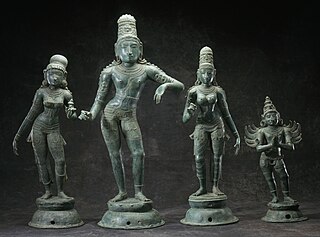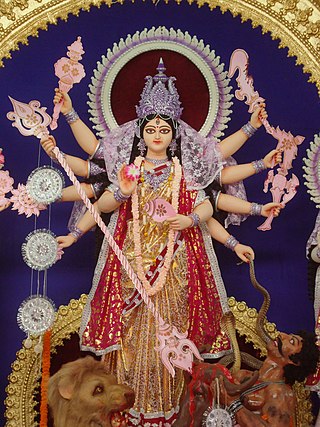
Adi Shankara, also called Adi Shankaracharya, was an 8th-century Indian Vedic scholar and teacher (acharya). His works present a harmonizing reading of the sastras, with liberating knowledge of the self at its core, synthesizing the Advaita Vedanta teachings of his time.

Brahmin is a varna as well as a caste within Hindu society. In the Vedic- and post-Vedic Indian subcontinent, Brahmins were designated as the priestly class, serving as priests and spiritual teachers. The other three varnas are the Kshatriya, Vaishya, and Shudra.

Lingayatism is a Hindu denomination based on Shaivism. Initially known as Veerashaivas, since the 12th-century adherents of this faith are known as Lingayats.

Basava (1131–1196), also called Basaveshwara and Basavanna, was an Indian philosopher, poet, Lingayat social reformer in the Shiva-focused bhakti movement, and a Hindu Shaivite social reformer during the reign of the Kalyani Chalukya/Kalachuri dynasty. Basava was active during the rule of both dynasties but reached the peak of his influence during the rule of King Bijjala II in Karnataka, India.
Kalady or Kaladi is a town located between Angamaly and Perumbavoor, east of the Periyar river, near to Malayattoor in Ernakulam district of Kerala, India, not far from Cochin International Airport. It is notable as the birthplace of 9th century Indian philosopher Adi Shankara.
Sampradaya, in Indian origin religions, namely Hinduism, Buddhism, Jainism, and Sikhism, can be translated as 'tradition', 'spiritual lineage', 'sect', or 'religious system'. To ensure continuity and transmission of dharma, various sampradayas have the Guru-shishya parampara in which parampara or lineage of successive gurus (masters) and shishyas (disciples) serves as a spiritual channel and provides a reliable network of relationships that lends stability to a religious identity. Shramana is vedic term for seeker or shishya. Identification with and followership of sampradayas is not static, as sampradayas allows flexibility where one can leave one sampradaya and enter another or practice religious syncretism by simultaneously following more than one sampradaya. Samparda is a punjabi language term, used in Sikhism, for sampradayas.

Dakṣiṇāmnāya Śrī Śāradā Pīṭham or Śri Śṛṅgagiri Maṭha is one amongst the four cardinal pīthams following the Daśanāmi Sampradaya - the peetham or matha is said to have been established by acharya Śrī Ādi Śaṅkara to preserve and propagate Sanātana Dharma and Advaita Vedānta, the doctrine of non-dualism. Located in Śringerī in Chikmagalur district in Karnataka, India, it is the Southern Āmnāya Pītham amongst the four Chaturāmnāya Pīthams, with the others being the Dvārakā Śāradā Pītham (Gujarat) in the West, Purī Govardhana Pīṭhaṃ (Odisha) in the East, Badri Jyotishpīṭhaṃ (Uttarakhand) in the North. The head of the matha is called Shankarayacharya, the title derives from Adi Shankara.

The history of Hinduism covers a wide variety of related religious traditions native to the Indian subcontinent. It overlaps or coincides with the development of religion in the Indian subcontinent since the Iron Age, with some of its traditions tracing back to prehistoric religions such as those of the Bronze Age Indus Valley Civilisation. Hinduism has thus been called the "oldest religion" in the world. Scholars regard Hinduism as a synthesis of various Indian cultures and traditions, with diverse roots and no single founder. This Hindu synthesis emerged after the Vedic period, between c. 500 and 200 BCE and c. 300 CE, in or after the period of the Second Urbanisation, and during the early classical period of Hinduism. It flourished in the medieval period, with the decline of Buddhism in India.

A matha, also written as math, muth, mutth, mutt, or mut, is a Sanskrit word that means 'institute or college', and it also refers to a monastery in Hinduism. An alternative term for such a monastery is adheenam. The earliest epigraphical evidence for mathas related to Hindu-temples comes from the 7th to 10th century CE.

The Smartatradition, also called Smartism, is a movement in Hinduism that developed and expanded with the Puranas genre of literature. It reflects a synthesis of four philosophical strands, namely Uttara Mīmāṃsā, Advaita, Yoga, and theism. The Smarta tradition rejects theistic sectarianism, and is notable for the domestic worship of five shrines with five deities, all treated as equal – Ganesha, Shiva, Shakti, Vishnu and Surya. The Smarta tradition contrasted with the older Shrauta tradition, which was based on elaborate rituals and rites. There has been a considerable overlap in the ideas and practices of the Smarta tradition with other significant historic movements within Hinduism, namely Shaivism, Brahmanism, Vaishnavism, and Shaktism.

Dasanami (IAST Daśanāmī Saṃpradāya "Tradition of Ten Names"), also known as the Order of Swamis, is a Hindu monastic tradition of "single-staff renunciation" generally associated with the four cardinal mathas of the Advaita Vedanta tradition and, according to tradition, organized in its present form by Vedic scholar and teacher Adi Shankaracharya.
Shanmata meaning "Six Sects" in Sanskrit, is a system of worship, believed by the Smarta tradition to have been founded by Adi Shankara, [circa 8th Century CE] Hindu philosopher. It centers around the worship of the six main deities of Hinduism, Shiva, Vishnu, Shakti, Ganesha, Surya and Skanda. In this system, six major deities are worshipped. This is based on the belief in the essential oneness of all deities, the unity of Godhead, and their conceptualization of the myriad deities of India as various manifestations of the one divine power, Brahman.

Panchayatana puja also known as Pancha Devi Deva Puja is a system of puja (worship) in the Smarta sampradaya, which is one of four major sampradaya of Hinduism. It consists of the worship of five deities set in a quincunx pattern, the five deities being Ganesha, Adi Shakti, Shiva, Vishnu and Surya. Sometimes an Ishta Devata or Kartikeya is the sixth deity in the mandala.

Sthānika Brāhmins belong to Hindu Tuluva Smartha Brahmin group.

Sadh Vaishnavism, , is a denomination within the Vaishnavism—Bhagavata tradition of Hinduism. Sadh Vaishnavism was founded by thirteenth century philosopher-saint Madhvacharya, who developed the Tattvavada (dvaita) Vedanta sub-school of Hindu philosophy.

In Hinduism, Shakti is the fundamental cosmic energy and a central deity within Shaktism, a significant theological tradition of Hinduism. Representing dynamic forces that permeate the universe, Shakti embodies feminine energy and is often depicted as the consort of Shiva. In this tradition, Devi, the Goddess, is regarded as the Supreme Brahman herself, with all other divine forms seen as her manifestations. The worship of Shakti entails a diverse array of goddesses, including Durga, Kali, Parvati, and Tripura Sundari, each representing unique facets of her power.
Hindu denominations, sampradayas, traditions, movements, and sects are traditions and sub-traditions within Hinduism centered on one or more gods or goddesses, such as Vishnu, Shiva, Shakti and so on. The term sampradaya is used for branches with a particular founder-guru with a particular philosophy.
Cukkemane or Kukkemane or Cuckemane is surname or a family name belonging to members of the Havyaka Brahmin Community. They belong to the Gautama gotra; they originate from and are mainly based in Kodagu (Coorg), Karnataka, a state in South India. They are from Kukke which was part of Amara Sulya district, formerly in the old kingdom of Kodagu.

Hinduism is the most followed Religion in India and nearly 84% of the total population of Karnataka follows Hinduism, as per 2011 Census of India. Several great empires and dynasties have ruled over Karnataka and many of them have contributed richly to the growth of Hinduism, its temple culture and social development. These developments have reinforced the "Householder tradition", which is of disciplined domesticity, though the saints who propagated Hinduism in the state and in the country were themselves ascetics. The Bhakti movement, of Hindu origin, is devoted to the worship of Shiva and Vishnu; it had a telling impact on the sociocultural ethos of Karnataka from the 12th century onwards.
Kannada Brahmins are Kannada-speaking Brahmins, primarily living in Karnataka, and also present in the states of Telangana, Andhra Pradesh, Kerala, and Tamil Nadu. They belong to one of three traditions: Smartism, Sadh Vaishnavism, and Sri Vaishnavism, and are followers of Adi Shankara, Madhvacharya, and Ramanuja respectively.













